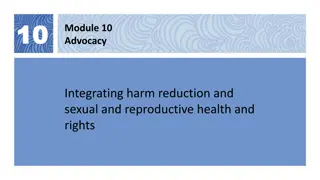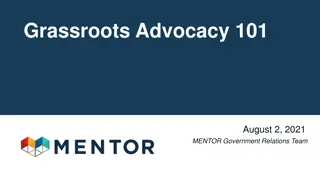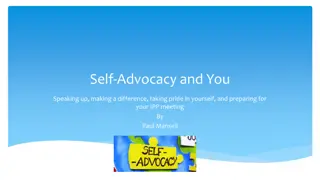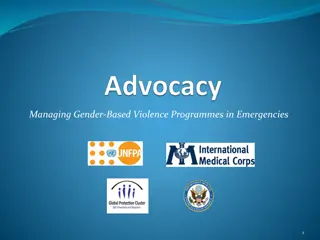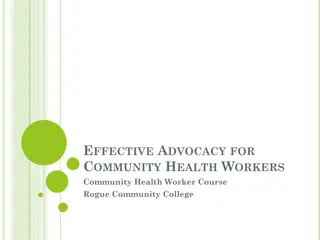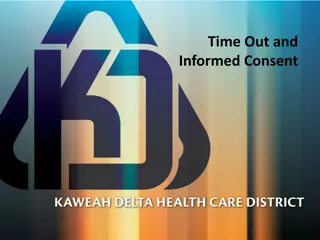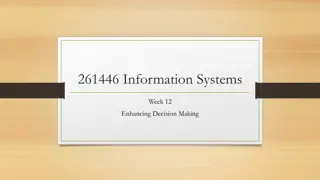Patient Advocacy and Informed Decision-Making
Understanding the importance of patient information in healthcare, this announcement covers topics such as the impact of hospital garb on patients, reasons why patients adopt certain roles in healthcare settings, patient-provider communication dynamics, the debate on how much information doctors should disclose to patients, and the benefits of informed patient care according to a study by social psychologist Irving Janis. It also touches on the significance of social support in surgical recovery scenarios.
Download Presentation

Please find below an Image/Link to download the presentation.
The content on the website is provided AS IS for your information and personal use only. It may not be sold, licensed, or shared on other websites without obtaining consent from the author.If you encounter any issues during the download, it is possible that the publisher has removed the file from their server.
You are allowed to download the files provided on this website for personal or commercial use, subject to the condition that they are used lawfully. All files are the property of their respective owners.
The content on the website is provided AS IS for your information and personal use only. It may not be sold, licensed, or shared on other websites without obtaining consent from the author.
E N D
Presentation Transcript
ANNOUNCEMENTS 1. Diary Study a. You should complete Dairy 6 today b. Diary Write Up will be explained on Tuesday April 16 2. Final Exam: May 7, 11:45 to 1:15 Everything from Midterm to final lecture. 50 multiple choice + 4 Extra Credit questions 3. Quiz 2 Results: Classdid well. Average 81% correct. Grades on Canvas
Quiz 2 Performance Ave. Score = 81%
Review Question 1 For patients, hospital garb has what negative effect? ____ An added expense most can t afford ____ There is little choice in color or design, offending personal style ____ Imposes childish, infirmed, low-status identity ____ Rarely allowed to take garb home, as souvenir of important event ____ None of the above X
Review Question 2 Why do patients often fall into good patient role? ____ Hospitals place them in role of dependent child, who seeks to please. ____ Hospitals have legitimate needs for them to cooperate ____ Patients try to win the favor of staff to get better attention ____ Patients superstitious belief that MDs have god-like healing powers ____ All the above X
Class 22 Being a Patient (finish) Patient / Provider Communication (start)
Should MDs Inform Patients? If So, How Much? What are problems with informing patients? What are problems with not informing patients? What about uncertain diagnoses? You have a 40% chance of X illness .
The Informed Patient Irving Janis ideal anxiety approach (1958) 1918-1990 Hospital hires Janis (social psychologist) to reduce patient stress Janis redefines situation: Some anxiety is good. Why? No anxiety person not prepared for difficult outcomes. Too much anxiety person is flooded, can t take in information. Recommends providing pats. with enough info to emotionally prepare. Egbert study (1964): Works with pats. undergoing abdominal surgery Patients either told / not told what to expect post-surgery (pain, recovery, severity, etc.) Result: Informed pats need less narcotics, leave hospital sooner. Highly replicated finding.
Social Support and Surgical Recovery You are about to undergo surgery. Would you prefer: ____ Private room (no roommate) ____ Roommate who is about to undergo same/diff surgery ____ Roommate who is in recovery from same/diff surgery Kulik & Mahler study (1996) Patients pared with roommate who is: * Undergoing same / different surgery * Pre-operative / post-operative What matters in terms of patients recovery?
Social Support and Surgical Recovery: Roommate Same or Different Condition Kulik, Mahler, and Moore (1996) Walking Post-Surgery 300 Yards Walked 250 200 150 100 50 0 No Roomate Roommate Different Condition Roommate Same Condition Days in Hospital Post Surgery 12 10 8 6 4 2 0 No Roomate Roommate Different Condition Roommate Same Condition Paired with post-op: Less anxious
Responsibility and Care-Giving on Patient Outcomes Rodin & Langer, 1977 Subjects are nursing home elderly. Cond. 1: Reminded of their own responsibilities, and given a plant to care for. Cond. 2: Reminded of staff responsibilities to them, and given a plant that staff cares for. 18 months later: Staff ratings, mortality. Who does better? 1 Cond ___ : * More positive staff ratings (happier, more sociable) * Lower mortality (more likely still alive) Key Points Slides 6-9: Pats. do better when autonomy, efficacy restored. 1. Informed about condition: Diagnoses, discomfort 2. Roommate who can help interpret treatment, foresee outcomes. 3. Given responsibility, meaningful tasks.
Animal Assisted Therapy Animal Assisted Therapy (AAT): Specially trained animals plus handlers visit hospitalized patients. Dog lies on patient's bed, is petted. Cute, but does it work? Experiment by Kathie Cole, RN, UCLA Medical Center 77 heart-failure patients (ave. age = 57) receive 12 minute visit from either: a. Dog b. Human volunteer c. No visit
Results of AAT Study: The Paws that Refreshes Anxiety: Dog: Human: Down 24 pts Down 10 pts Epinephrine Dog: Human: Control: Down 17% Down 02% Up 07% Blood pressure Dog: Human: Control: Down 10% Up 03% Up 05% Why are dogs better than humans?
Elephant-Assisted Therapy: South Africa Dolphin-Assisted Therapy: Israel, Florida, Ukraine
Therapeutic Riding and Cerebral Palsy Veronic Skoczek and MacGuyver: Skoczek suffers from cerebral palsy, affects walking and other motion. After years of therapeutic riding walks unassisted. Rhythm of horse s gait mimics pelvic movement during walking. Improves alignment, muscle symmetry, postural control https://www.nsarco.com Emotional Support Animal Registry https://www.esaregistration.org/ther apy-dog-and-animal-info/
Children in Hospitals Hospitals are frightening to children. a. Place associated with pain b. Sad/Scary looking patients d. Parents are not in control Emotional reactions a. Fear, anxiety b. Anger, rebellion c. Shame (esp. at adolescence) Being left overnight in hospital esp. upsetting. a. "Setting" anxiety b. Age 3-6: fear rejection c. Age 4-6 develop new fears (e.g., darkness) d. Age 6-10 free-floating anxiety e. Separation anxiety: deserted? punished?
Social-Psychological Tx for Hospitalized Children Social Support Psychological Control a. Kid in Hospital movie --> less anxiety b. In gen., informed kids show less anxiety c. Encourage kids to ask questions d. Provide kids with coping skills a. Parental visits study (Branstetter, 1969) Cond 1. Mom at visiting hours only Cond 2. Mom for extended periods Cond 3. Surrogate mom b. Kids in Cond 2 & 3 do better than Cond 1 c. Hospitals now let parents stay with kid all times d. Story telling * Self-talk * Relaxation skills
Story Telling for Hospitalized Children Story telling an ancient part of human civilization. Our minds are soothed by stories. Provide meaning and order; a beginning, middle, end. Hospitals include storytelling to children-patients. Eases anxiety and fear. Provides a mental vacation . May reduce pain. https://storynet.org/groups/hsa/healing- story-alliance-hsa/
Class 24 Patient / Provider Communication
Why Providers Are Often Poor Communicators Situation: Time pressed, competing demands ( Jerusalem to Jericho ) Medical Training: Communication and compassion not emphasized Communication skills not modeled. MD training is itself inhumane. Self Selection Motives for becoming MD sometimes contrary to compassion/listening prestige, wealth, status, authority Some MD skills contrary to compassion/listening: Detachment Analytic / time-efficient / detail oriented Personality qualities needed to get into med school Competitive: Cerebral Technical
MD Failure to Listen Beckman & Frankel (1984) study of MD initial response to patients MDs know they are being observed, 74 patient visits Patient given opportunity to explain problem: 23% MD interrupts, directs pat. to particular disorder: 69% MD interrupts pat. after _____________ of elapsed time. 18 seconds Consequences? 1. Patients don t get a chance to fully explain symptoms, concerns. 2. MD doesn t get all vital information
MD Communication Problems 1. Failure to listen 2. Use of jargon: Hmm. Seems you have Ulag's Syndrome, which voraciously perturbs the ipsilateral medulla of the flataboig. Arnold of Villanova (1235-1311): [Tell the patient that] he has an obstruction of the liver, and particularly use the word obstruction because patients do not understand what it means.
MD Communication Problems (contin.) 3. Baby talk: Is you got a boo-boo on your spleen? Might especially be a problem for older patients (e.g., Giles, 1991). 4. Depersonalization: MD sees pat. as condition, not a person Refer to pat. in third person, in front of pat. Need to get his name and address, and what s his primary symptom Functions: Manages pat., improves efficiency in emergency Effect on Pat: Can calm: Help dissociate from fearful situation Can alarm: I see this condition terminating in negative status
Inappropriate Emotions MD looks frightened, distressed, frustrated. Holy Toledo, look at that spot on your X-ray!!!! Women who get mammogram, if MD appears worried, they: a. Remember less b. See situation as worse c. Higher pulse rates







